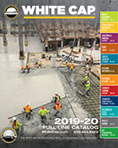How To Stay Ahead In 2020
READ IN SPANISH
Staying Productive Is Critical, Now More Than Ever
Even before the emergence of COVID-19 some experts were predicting that 2020 could indicate a slight slowdown in the steady pace of construction. Following the Great Recession of 2008, the construction industry made a comeback and has been operating at a steady strength. While some economic indicators had recently been predicting a forthcoming downtick in certain segments of construction, the area of nonresidential construction showed potential for slow growth.
Construction And Covid-19
The American Institute of Architects (AIA) Consensus Construction Forecast for 2020 has forecasts from a group of well-known construction economists that mark a wide channel of slow growth from -0.4% to +4.4% in the nonresidential segment. These stats are from early 2020, so it remains to be seen how the coronavirus pandemic will alter these projections.
The onset of COVID-19 has slowed down construction starts and even stopped some jobs dead in their tracks. Respondents to a survey, released on 4-3-20 from the Associated General Contractors of America, indicate that 30% were asked by the federal government to shut down construction sites and 53% said projects had been delayed. The good news is only 7% had cancelled the job completely.
The National Association of Home Builders (NAHB) has compiled a helpful safety toolbox talk on contractors navigating the coronavirus.
Once the economy kicks in and construction projects ramp back up, contractors should employ a “hope for the best and plan for the worst” mentality.
Let’s look at some of the ways contractors can sharpen their edge now and in the coming months.
Forge Beneficial Relationships
Having a pipeline full of work is the ideal but that isn’t always the reality. One way to keep your pipeline as full as possible is by continuously cultivating professional relationships. Partnering with large construction companies with bigger jobs can help ensure a more consistent pipeline of work. Bigger companies are more able to keep jobs moving during economic downturns or unplanned work stoppages such as COVID-19.
To build relationships, consider:
- Partnering with entities that finance projects (i.e., builders and owners) as they are more likely to drive the continuation and completion of jobs.
- Marketing your company to your existing contacts and then targeting new companies or markets to explore.
- Ensuring your company is nimble and able to shift priorities to meet changing needs. Being immediately available to a partner in need could make the difference in who wins the job.
Don’t Overextend
A good rule of thumb is not to overstretch projects or finances. However, today many companies may find themselves overextended in all directions. Suddenly idle jobs mean delaying project completion or laying off workers. A month ago, it was business as usual and today, some contractors are facing an uncertain financial future. The following are best practices for keeping a competitive financial edge no matter the economic outlook.
- Contractors should do their level best to ensure that building owner financing is in place. Ensuring that owner’s financing is stable makes it more likely that bills will get paid during boom or bust. And, contractors have a right to ask for that information up front.
- Contractors also need to ensure their own financing is in order. In todays’ climate, having cash-on-hand is imperative. Hopefully, there is something put away for a rainy day because these days, there’s rain in forecast.
- Ensure financial information is up to date, accessible and accurate. Keep receipts out of the shoebox and make sure you have a financial expert managing your paperwork. This goes for big companies all the way down to small contractors. Having your financial information readily accessible allows you to hit the ground running when work restarts.
- Now may not be the time branch out into a new area of construction. While it may be tempting to open up to all offers and opportunities, in this uncertain time, it makes more sense for contractors to stick to their expertise and what you are best at. There will be time to grow and expand down the road.
Keep Costs In Check
Material prices, taxes and tariffs, and other costs can fluctuate over the life of a construction project. Over longer projects in particular, material costs can change due to circumstances beyond anyone’s control. To hedge against a potential rise in cost, add an escalation clause into contracts. If material prices rise above what was agreed to in the original bid, the contractor would be entitled to full or partial reimbursement.
Particularly now, costs are uncertain, (especially on commodity materials like copper, steel, iron, rebar, etc.), so this type of insurance policy offers another way to get an edge over the competition. Including escalation clauses in contracts can mitigate a rise in material price.
There are three types of clauses:
- Compensates contractors right away – these ‘day one’ provisions allow contractors to receive immediate reimbursement for an uptick in material costs.
- Compensates contractors after a certain amount of time – for longer-term projects this category would allow for cost recovery over a set period of time.
- Risk sharing between contractor and owner – contractors would be eligible for reimbursement after a higher threshold had been reached. Below the threshold, the contractor would bear the cost. This would be more suited to large jobs with big budgets.
Every contractor must evaluate which, if any, escalation clause works best for their job size and budget. Any tool that provides insurance against loss provides a competitive advantage.
Embrace New Technologies
In order to truly stay competitive in the 21st Century, contractors must embrace the use and implementation of technology into their business. Whether it’s wearable smart devices that attach to helmets and clothing, or project management software, technology is ubiquitous and is making a real difference on the jobsite. In fact, the inability to navigate technology will be a serious disadvantage in the not too distant future. Harnessing technology is vital and offers a significant competitive edge to contractors.
- Wearable devices offer a new layer of safety for construction workers. These smart devices track physical location by GPS and can also monitor worker vital signs. They can be especially helpful if the wearer is hurt or incapacitated; wearables make it easy to locate an errant or unconscious worker.
- Project management software changes the way construction projects can run. Project management information systems allow for the organization of all aspects of a job, such as budgeting, staffing, scheduling, reporting, ordering, and project planning. Being able to access all that information at any time from a single source on a laptop or tablet is a game changer. The upfront financial investment and time spent on the learning curve figuring out how operate the software will pay off. In fact, if project management software isn’t part of your current business, during this work stoppage due to COVID-19 is a good time to get it up and running when it won’t take away from ongoing work.
- Consider using construction drones to bolster your efficiency on your jobsites. Drones have been proven to help with surveying, detailed site maps, site security, measuring stockpiles, communications, and roof inspections.
- Workers entering the construction field will have already grown up with a great deal of technology at their fingertips. This younger generation will expect a certain amount of technology in their careers, even in jobs that haven’t typically been associated with it, like jobs in construction. As seasoned construction workers gain years, younger generations can help contractors spearhead technology adoption across the organization. Older holdouts may find it’s not as complicated as they thought.
The bottom line is that innovations and trends in construction will occur with technology. Be ready to hit the ground running and don’t get left behind.
Lean Into “Lean Construction”
Lean construction is a method of minimizing costs, materials, time and effort in construction projects. By adopting these practices and technologies contractors can reduce costs, resources, and time specific to the project at hand. Lean construction gives contractors a competitive edge by:
- Shortening Construction Time
- Reducing Costs
- Accelerating Activities
- Improving Planning
- Improving Process control
- Working With Suppliers To Time Product Deliveries
The promise of lean construction is less waste, greater value, and safer workplaces. But, how can contractors integrate solutions into projects today? Whether you jump all in with full integration or adopt a more incremental approach, the forced time off due to COVID-19 might be a great time to learn about and begin implementing lean construction principles.
Eliminating waste is a common theme every contractor can relate to. Start by taking inventory of your complete construction cycle from planning to delivery; chances are there is waste at every step. Apply lean construction systems to see how to identify the waste and eliminate unnecessary steps.
A Safe Path To Productivity
Use any downtime to optimize your business and train up your crew, not only on work skills and safety issues, but also on “Flattening The Curve” and avoiding the virus. This year has started out like no other in recent memory. Stay productive and stay safe. We’re all in this together.




